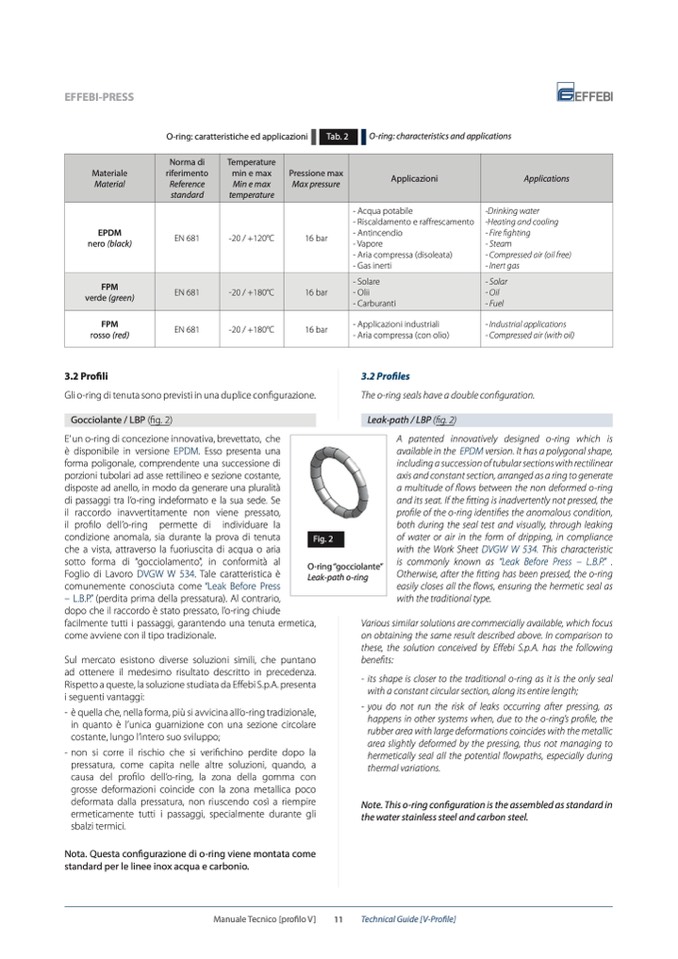
EFFEBI-PRESS
O-ring: caratteristiche ed applicazioni
Tab. 2
O-ring: characteristics and applications
Materiale
Material
Norma di
riferimento
Reference
standard
Temperature
min e max
Min e max
temperature
Pressione max
Max pressure
Applicazioni
Applications
EPDM
nero (black)
EN 681
-20 / +120°C
16 bar
- Acqua potabile
- Riscaldamento e raffrescamento
- Antincendio
- Vapore
- Aria compressa (disoleata)
- Gas inerti
-Drinking water
-Heating and cooling
- Fire fighting
- Steam
- Compressed air (oil free)
- Inert gas
FPM
verde (green)
EN 681
-20 / +180°C
16 bar
- Solare
- Olii
- Carburanti
- Solar
- Oil
- Fuel
FPM
rosso (red)
EN 681
-20 / +180°C
16 bar
- Applicazioni industriali
- Aria compressa (con olio)
- Industrial applications
- Compressed air (with oil)
3.2 Profili
3.2 Profiles
The o-ring seals have a double configuration.
Leak-path / LBP (fig. 2)
A patented innovatively designed o-ring which is
available in the EPDM version. It has a polygonal shape,
including a succession of tubular sections with rectilinear
axis and constant section, arranged as a ring to generate
a multitude of flows between the non deformed o-ring
and its seat. If the fitting is inadvertently not pressed, the
profile of the o-ring identifies the anomalous condition,
both during the seal test and visually, through leaking
of water or air in the form of dripping, in compliance
with the Work Sheet DVGW W 534. This characteristic
is commonly known as “Leak Before Press – L.B.P.” .
Otherwise, after the fitting has been pressed, the o-ring
easily closes all the flows, ensuring the hermetic seal as
with the traditional type.
Various similar solutions are commercially available, which focus
on obtaining the same result described above. In comparison to
these, the solution conceived by Effebi S.p.A. has the following
benefits:
- its shape is closer to the traditional o-ring as it is the only seal
with a constant circular section, along its entire length;
- you do not run the risk of leaks occurring after pressing, as
happens in other systems when, due to the o-ring’s profile, the
rubber area with large deformations coincides with the metallic
area slightly deformed by the pressing, thus not managing to
hermetically seal all the potential flowpaths, especially during
thermal variations.
Note. This o-ring configuration is the assembled as standard in
the water stainless steel and carbon steel.
Gli o-ring di tenuta sono previsti in una duplice con
figurazione.
Gocciolante / LBP (fig. 2)
E’ un o-ring di concezione innovativa, brevettato, che
è disponibile in versione EPDM. Esso presenta una
forma poligonale, comprendente una successione di
porzioni tubolari ad asse rettilineo e sezione costante,
disposte ad anello, in modo da generare una pluralità
di passaggi tra l’o-ring indeformato e la sua sede. Se
il raccordo inavvertitamente non viene pressato,
il profilo dell’o-ring permette di individuare la
condizione anomala, sia durante la prova di tenuta
che a vista, attraverso la fuoriuscita di acqua o aria
sotto forma di “gocciolamento”, in conformità al
Foglio di Lavoro DVGW W 534. Tale caratteristica è
comunemente conosciuta come “Leak Before Press
– L.B.P.” (perdita prima della pressatura). Al contrario,
dopo che il raccordo è stato pressato, l’o-ring chiude
facilmente tutti i passaggi, garantendo una tenuta ermetica,
come avviene con il tipo tradizionale.
Sul mercato esistono diverse soluzioni simili, che puntano
ad ottenere il medesimo risultato descritto in precedenza.
Rispetto a queste, la soluzione studiata da Effebi S.p.A. presenta
i seguenti vantaggi:
- è quella che, nella forma, più si avvicina all’o-ring tradizionale,
in quanto è l’unica guarnizione con una sezione circolare
costante, lungo l’intero suo sviluppo;
- non si corre il rischio che si verifichino perdite dopo la
pressatura, come capita nelle altre soluzioni, quando, a
causa del profilo dell’o-ring, la zona della gomma con
grosse deformazioni coincide con la zona metallica poco
deformata dalla pressatura, non riuscendo così a riempire
ermeticamente tutti i passaggi, specialmente durante gli
sbalzi termici.
Nota. Questa configurazione di o-ring viene montata come
standard per le linee inox acqua e carbonio.
Fig. 2
O-ring “gocciolante”
Leak-path o-ring
Manuale Tecnico [profilo V]
11
Technical Guide [V-Profile]

